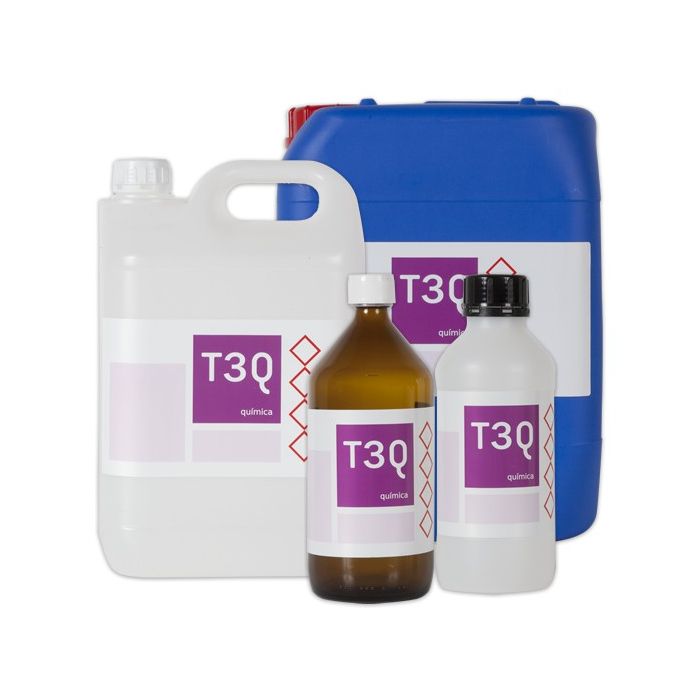Sulfuric acid 30% 27º BE
Sulfuric acid 30% 27º BE
What is Sulfuric Acid?
Sulfuric acid is one of the most widely used chemicals in the world. Due to its wide variety of applications, it has been used in most industrial sectors, which is why it is the chemical with the highest production volume.
Sulfuric acid is a highly corrosive and very reactive compound that appears as a heavy, oily, colorless liquid.
Composition
Sulfuric acid is obtained by oxidizing sulfur dioxide, which gives it a distinctive smell. It is soluble in water and has a strong dehydrating effect.
It is also a potent oxidizing agent and reacts with metals at high temperatures.
Formula of sulfuric acid: H₂SO₄
Main Uses
Sulfuric acid is used in most industrial sectors. Its most common uses include:
- Oil refining
- Production of pigments
- Manufacturing of drying oils
- Paraffin manufacturing
- Kerosene manufacturing
- Metal treatment
- Detergent manufacturing
- Household drain cleaners
Where to Buy Sulfuric Acid
At T3Química, we offer sulfuric acid for online purchase in various quantities and concentrations. Orders will be delivered within 72 hours (in-stock orders). On our website, you will find sulfuric acid in the following concentrations:
- Sulfuric acid 30% 27º BE
- Sulfuric acid 36% 31º BE
- Sulfuric acid 38% 32º BE
- Sulfuric acid 44% 37º BE
- Sulfuric acid 50% 41º BE
- Sulfuric acid 60% 47.85º BE
On our website, you will find sodium cyanide in the following formats:
- 1 L container of sulfuric acid
- 5 L container of sulfuric acid
- 10 L container of sulfuric acid
- 20 L container of sulfuric acid
- 25 L container of sulfuric acid
- 50 L container of sulfuric acid
If you need other types of containers or special quantities, you can contact us directly by email or phone. We manufacture different types of containers based on our customers' needs.
Key Considerations
It is recommended to use proper protective equipment when handling sulfuric acid. Due to its high corrosivity, even small amounts of contact with the skin can cause severe chemical burns.
Accidental contact of sulfuric acid with the eyes can cause permanent damage and blindness. Store in a cool, dry, and well-ventilated place.
Compatibility
Compatible with: Mainly water and some organic compounds.
Not compatible with: Not compatible with strong bases or certain metals like aluminum and zinc, which can react by generating hydrogen gas and heat.
Frequently Asked Questions
Is handling sulfuric acid dangerous?
Yes, sulfuric acid is highly corrosive and can cause severe burns to the skin and eyes. It should be handled with extreme caution, using appropriate protective equipment.
How is sulfuric acid produced industrially?
Sulfuric acid is primarily produced by the contact process, which involves the oxidation of sulfur dioxide with oxygen in the presence of a catalyst.
How can the formation of toxic sulfuric acid clouds be prevented in industrial environments?
To prevent the formation of toxic sulfuric acid clouds, emission control measures such as proper ventilation systems and gas containment equipment should be implemented. Additionally, strict safety protocols should be followed when handling and storing the acid.
What is the difference between concentrated and diluted sulfuric acid?
Concentrated sulfuric acid has a high concentration of sulfuric acid (usually around 95-98%), while diluted sulfuric acid has a lower concentration, as it has been mixed with water. Concentrated sulfuric acid is more corrosive and used in industrial applications, while diluted sulfuric acid is used in gentler applications, such as cleaning or in laboratories.
How can sulfuric acid be recycled or reused in industry?
Sulfuric acid can be recycled through regeneration processes that separate the water from the acid for reuse in industrial processes. It can also be used in secondary applications such as fertilizer production or neutralizing alkaline waste.
| Pictogramas | Corroasive substances (CR) |
|---|

